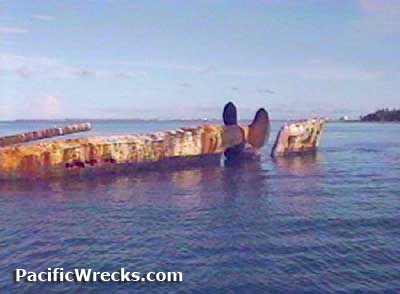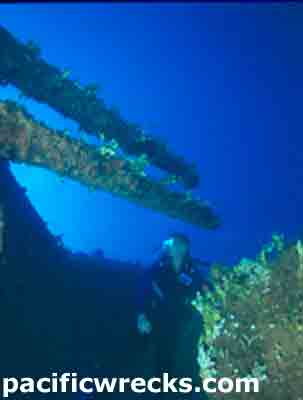|
|
|
|
| Missing In Action (MIA) | Prisoners Of War (POW) | Unexploded Ordnance (UXO) |
| Chronology | Locations | Aircraft | Ships | Submit Info | How You Can Help | Donate |
|
| USN unclassified miscellaneous vessel Former Assignments Kriegsmarine Admiral Hipper Class Heavy Cruiser 16,970 Tons (Normal) 19,050 Tons (Full Load) 697' 2" x 71' 2" x 24' 8 x 20.3 cm guns 12 x 10.5 cm SK C/33 guns 12 x 3.7 cm C/30 guns 8 x 2 cm C/30 guns 12 x 53.3 cm torpedo tubes 4 x 40mm 3 x Ar 196 1 x catapult  Kriegsmarine 1939  Kriegsmarine 1940  USN May 1945  USN March 1946    Peter Ording 2001  Google Earth 2017 Google Earth 2017 |
Ship History Built by Krupp Germaniawerft (Germania shipyard) in Kiel. Laid down April 23, 1936 with construction number 564 and the contract name Kreuzer J. as an Admiral Hipper-class heavy cruiser with a planned displacement of 10,160 tons set by the Anglo-German Naval Agreement of 1935. When completed the warship was 16,970 tons. The heavy cruiser was to be named Wilhelm von Tegetthoff, the Austrian victor of the Battle of Lissa, though the idea was dropped due to considerations over the possible insult to Axis ally Italy that lost the battle. Launched August 22, 1938 as Prinz Eugen named after Prince Eugene of Savoy, an 18th century Austrian General. The launching ceremony was attended by Adolf Hitler and the christening speech was given by Reichsstatthalter (Governor) of Ostmark, Arthur Seyss-Inquart. Also present was the Regent of Hungary, Admiral Miklós Horthy whose wife Magdolna Purgly, christened the warship. On July 1, 1940 during a Royal Air Force (RAF) air raid against Kiel and was hit twice causing light damage but was quickly repaired. Commissioned August 1, 1940 into the Kriegsmarine (German Navy). Afterwards, conducted sea trials in the Baltic Sea with gunnery training in early 1941 followed by a brief period in dry dock for modification and improvement. Wartime History In April 1941 joined Battleship Bismarck for exercises in the Baltic Sea. During Operation Rheinübung Eugen and Bismarck attempted to reach the Atlantic Ocean between May 17-27, 1941 and was her first sea engagement. On May 24, 1941 during the Battle of the Denmark Strait engaged and sank HMS Hood (51) and damaged HMS Prince of Wales but resulted in heavily damaged Bismarck being scuttled. Afterwards Prinz Eugen had engine problems and underwent repairs in France. During Operation Cerberus a daylight dash through the English Channel to Germany was her second sea engagement between February 11-13, 1942. Next, deployed to Norway. On February 23, 1942 hit in the stern by a torpedo fired by HMS Trident (N52) that that required repairs in Germany. Afterwards, trained officer cadets in the Baltic Sea, Finally, provided fire support for the retreating German Army on the Eastern Front between October 1944 until April 1945. During World War II, Prinz Eugen was considered a lucky ship and one of the few warships that survived until the end of the War in Europe. By early May 1945 in drydock in Bremen. On May 8, 1945 when Germany surrendered, Prinz Eugen and Nürnberg the only major German warships to survive in serviceable condition and are surrendered to the Royal Navy at Copenhagen. On May 27, 1945 Prinz Eugen and Nürnberg were escorted by HMS Dido (37) and HMS Devonshire (39) to Wilhelmshaven. The fate of the remaining German warships were decided by a lottery between Control Commission representatives from the United Kingdom, Soviet Union and United States. Postwar On December 13, 1945 representing the United States, U.S. Navy Captain Arthur H. Graubart drew the Prinz Eugen and the warship became American property. Commissioned into the U.S. Navy (USN) as unclassified miscellaneous vessel USS Prinz Eugen (USS IX 300) under the command of Captain Arthur H. Graubart. To move the war prize to the United States, composite crew was formed of 574 former Kriegsmarine officers and sailors, supervised by eight U.S. Navy officers and eighty-five enlisted men. On January 13, 1946 departs Wesermünde bound for Boston arriving six days later. Next, steamed to Philadelphia for technical evaluation at the Naval Air Materiel Center. The fire control system that used in magnetic amplifier technology was studied. During February 1946 the guns from turret Anton were removed for testing. The GHG passive sonar array was removed and installed on USS Flying Fish (SS-229) for testing. Two of her floatplanes Ar 196 A-5 623167 and Ar 196 623183 were removed and retained by the U.S. Navy and the catapult studied and used for at least four hours of flight testing. In May 1946 the German crew were returned to Germany and afterwards the Americans had difficulty keeping the boilers operational with eleven of twelve failing soon after they departed. Instead of repairing the cruiser, Prinz Eugen was allocated as a target ship for Operation Crossroads. On March 3, 1946 towed from Philadelphia via the Panama Canal across the Pacific to Bikini Atoll. Anchored in the target area as ship number 36 moored about 1,200 yards / 1,100 meters from the epicenter of both tests to the southwest of Bikini Island (Pikinni). On July 1, 1946 survived atomic bomb test "Able" air burst with only light damage including a bent foremast and the top broken off her main mast. Although the ship sustained no major damage, it was contaminated with radioactive fallout. On July 25, 1946 survived atomic bomb test "Baker" submerged detonation and sustained no major damage but was weakened below the waterline. Afterwards, towed to Kwajalein Atoll and inspected for radiation and bomb damage. On August 29, 1946 decommissioned by the Navy. Over the next three months, the weakened hull began to take on water. Without a salvage team available, the Navy planned to beach the warship to prevent it from sinking. Sinking History On December 22, 1946 after dark, Prinz Eugen developed a 35 degree list then capsized and sank with the bottom of the hull and propellers above the surface on Enubuj Reef in the Southern Atoll of Kwajalein Atoll. Shipwreck The shipwreck remains in situ with a portion of the hull with the propellers and rudder partially exposed above the surface. As the ship capsized, her main gun turrets fell out of their barbettes. Today, the Prinz Eugen is easily accessible and safe for SCUBA divers. The interior structure are intact and safe for exploration but several divers have lost their lives in deep penetrations of the wreck. Divers anchor on the wooden wreck of small hull in 30' of water opposite the screws. The hull rests against the reef, but there is an opening at the 90' level, just forward of the bridge. The bow is at 110' and divers can swim under it with access to most of the shipwreck. The crew's quarters are accessible with remains of bunks and personal effects. Mess area contains crockery. A latrine. Machinery and fire fighting gear is suspended on the deck. Amidships much has fallen onto the seabed including some AA guns and their mounts. Some items have been recovered from the bridge. The armament two large turrets with twin 8 inch barrels. Large 4.1" guns, dual and quad AA guns are almost all still intact. Port torpedo tubes have torpedoes in them. To prevent fuel from leaking from the shipwreck, a plan was devised to pump out the fuel bunkers. Between February 2018 until October 15, 2018 an oil salvage operation under the command of Lieutenant Commander Tim Emge, aboard USNS Salvor (T-ARS-52) with divers from Mobile Diving and Salvage Unit One (MDSU-1) plus personnel from the U.S. Army and the Marshall Islands. Divers cut holes in the hull to access the fuel bunkers and pumped 250,000 US gallons of fuel into oil tanker Humber and removed an estimated 97 percent of the fuel aboard to protect the marine ecosystem. Display One of the screws was removed (date unknown) and returned to Germany. Today, it is displayed at the German Naval Memorial at Laboe. The ship's bell was removed by U.S. Navy sailors before to the atomic tests. Today, displayed at U.S. Navy Museum (The Navy Museum) in the Cold War Gallery with accession number NHHC 1970-198-A. References Prinz Eugen in Philadelphia Destinations Journey - Arado Ar 196 Floatplanes Serving Aboard Prinz Eugen (photos) Naval History and Heritage Command (NHHC) - Prinz Eugen Naval History and Heritage Command (NHHC) - Master File Drawings of German Naval Vessels Naval History and Heritage Command (NHHC) - Operation Crossroads: Disposition of Target Vessels Naval History and Heritage Command (NHHC) - Ship's Bell USS Prinz Eugen (IX-300) NavSource - Prinz Eugen (IX-300) Contribute
Information |
Map 1946 Photo Archive 0'-110' |
| Discussion Forum | Daily Updates | Reviews | Museums | Interviews & Oral Histories |
|